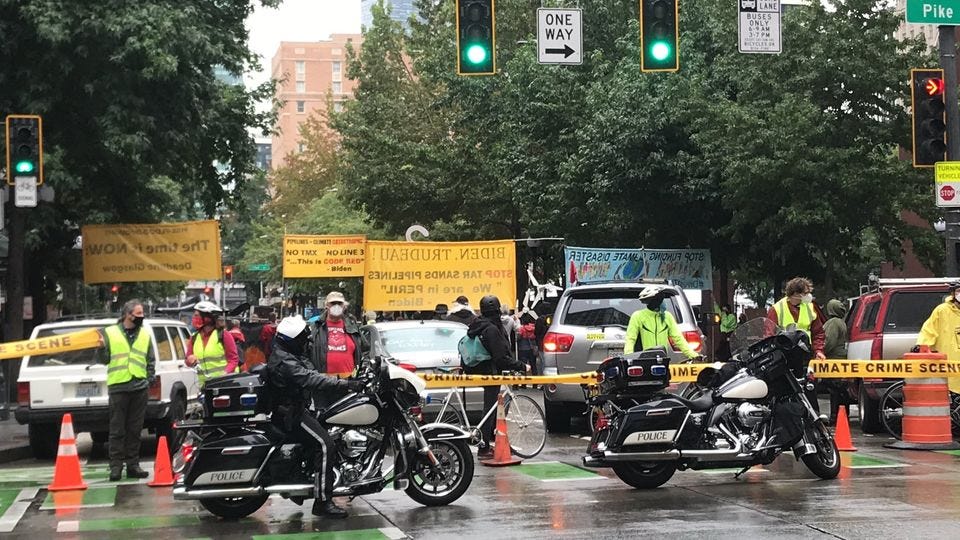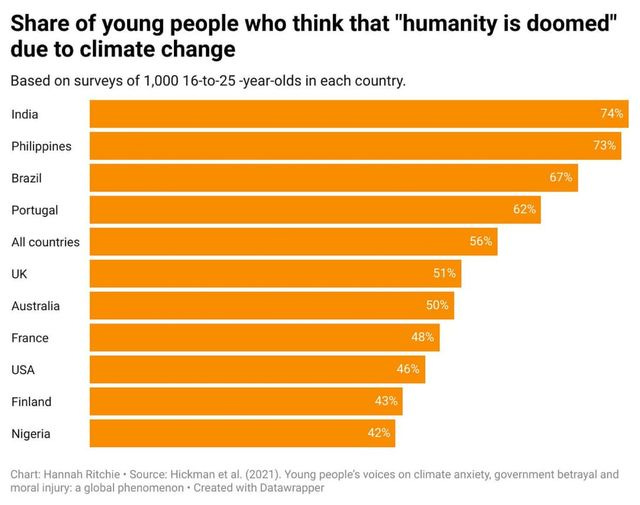If we don't get climate justice, shut it down
Time to get in the way of business as usual big time

8 minute read
I will return to my series on re-envisioning the United States shortly. Today I’m back on the climate beat. Just can’t stay away!
“If we don’t get climate justice, what do we do?“
“Shut it down!”
Call and response when we took a downtown Seattle street in front of the Canadian Consulate and Chase and Bank of America branches and shut it down for 1-1/2 hours last Friday. Our 350 Seattle activists took petitions signed by tens of thousands into all three locations, demanding an end to funding fossil fuel infrastructure, especially tar sands pipelines Line 3 in Minnesota and the Trans Mountain Pipeline in British Columbia, both of which cut through native lands. Outside, the crowd held signs, strung “CLIMATE CRIME SCENE” tape, worked props such as a Biden-Trudeau puppet, did street theater, and made noise.
The event was part of a nationwide wave of actions staged by Stop the Money Pipeline as part of the Deadline Glasgow: Defund Climate Chaos campaign, intended to build heat on political and business leaders to take action equal to the climate crisis at the COP26 climate summit in Scotland November 1-12. Ours was not intended to be an arrest action. The Seattle police were so good as to direct traffic around our blockade. The bike cops were nestled up against a building just out of sight waiting to clear us -using their bicycles as weapons - in case the order was given. But the authorities let our limited-time action pass, knowing it would just make a bigger story if the cops got violent. Over 40 activists were arrested at J.P Morgan & Chase headquarters in New York.
Today, Sept. 24, the youth-led Fridays for the Future stages another wave of protests with a global Climate Strike themed #UprootTheSystem. To find an event in your area, go here. I’ll be heading out to the Seattle action a little later today.
Uprooting the system, shutting it down, looks like what we’re going to have to do. The Glasgow climate summit, the 26th such meeting since 1995, is being framed as the last chance to do something serious about the onrushing climate catastrophe. But based on the record, Glasgow is likely to fail. Carbon pollution and fossil fuel use have steadily climbed upwards, as the following charts show.
Despite a renewable energy revolution, the fossil fuel share of global energy use has not budged in 10 years, remaining at 80.3%. At the 2015 Paris climate summit, world nations supposedly committed to hold global heating below 1.5-2°C. Yet even if they kept their commitments, which they are not, CO2 pollution would rise by at least 16% from 2010 levels by 2030, and more likely 19%, compared to the 45% decline needed to hold the increase below 1.5°, a United Nations report found. Said UN chief Antonio Guterres, “the world is on a catastrophic pathway to 2.7-degrees of heating.” The Glasgow meeting is at risk of failure, he said. Meanwhile a new report shows that from 2016-20 the world’s 60 largest banks invested $3.8 trillion in fossil fuels. Chase was the biggest offender.
A sane world would be dramatically cutting fossil fuel use now. CO2 concentrations are already at levels not seen in at least 3-5 million years, before humans existed, when trees grew in Antarctica and sea levels were something like 65 feet higher. Levels might even be greater than they were 23 million years ago. John Lennon said, “Our society is run by insane people for insane objectives . . . by maniacs for maniacal ends.” Like bank and oil company executives and their bought-and-paid-for politicians who are driving the world headlong into catastrophe.
This clearly isn’t working. It is time for the sane people to get in the way of business as usual, and on a sustained basis. Glasgow is the last chance for the global climate process to retain a shred of credibility. If COP26 doesn’t produce a solid plan to deeply cut climate-twisting pollution beginning immediately, which I hate to say is the likely outcome, it is time for serious, mass direct action. People power shutdowns of urban cores and government centers. Occupations of corporate offices and operations, and outside the homes of top corporate and political leaders. Shutdowns of highways such as activists are now doing on the London beltway. To make ourselves damned inconvenient. To nonviolently throw sand in the gears, stopping the flow on which business as usual depends.
TWO URBAN SHUTDOWNS
I have two examples in mind. I have participated in both.
In the first week of May 1971 while the Vietnam War was raging, around 25,000 antiwar activists converged on Washington, DC with the theme, “If the government doesn’t stop the war, we’ll stop the government.” Lawrence Roberts recounts the now largely forgotten event in a recent book, Mayday 1971. It was the largest civil disobedience mass arrest in U.S. history, over 12,000 over the course of the week. I was a young college student in D.C. at the time, and was arrested on the second day. My constitutional rights were unjustly violated on Constitution Avenue in front of the Justice Department, as was proven in a successful ACLU lawsuit from which I collected $2,500 10 years later. Richard Nixon’s own words in a late release of the White House tapes nailed the case.
Protesters were met by something like 14,000 police and military including the 82nd Airborne. Nixon surrounded his White House with a barricade of city buses several layers deep. He later called Mayday “turmoil bordering on insurrection,” though unlike the Capitol Hill events on Jan. 6, it remained largely nonviolent.
Mayday was the last of the great mass protests which had been building over several years. They were vital in persuading Nixon to reject military proposals for use of nuclear weapons in Vietnam, knowing that would cause even greater turmoil on U.S. streets. This is documented in Daniel Ellsberg’s The Doomsday Machine. The protests drove the U.S. to withdraw, rather than making Vietnam another permawar.
The second example was on my home turf, the Battle in Seattle Nov. 30, 1999 and following days when around 50,000 came out to protest the World Trade Organization meeting taking place in the city. We were opposing free trade agreements for the way they undermine labor rights and environmental protections. The labor-environmental coalition that staged the protest was called the turtles-teamsters alliance. I was one of around 10,000 that occupied the urban core, including that block where we staged the action last Friday. It was one of those unforgettable days of life, walking the line of body-armored police surrounding the meeting at the Washington State Convention Center. Though there was a level of property destruction by black bloc anarchists, most of the protesters were peaceful. Can’t say that about the cops. I learned something new that day. When you’re hit by teargas, don’t rub your eyes. Wash out with water.
Our presence outside strengthened the backs of developing nations representatives inside who were being pressured to open their markets even as the U.S. and Europe kept subsidizing their agriculture, a prospective disaster for farmers in the developing world. What was to be the Seattle Round of the WTO collapsed in failure. The next meeting in heavily fortified Doha set off the next round, but it failed for the same reason.
In both cases, direct action got the goods. People standing up to powerful institutions in the streets, putting their bodies in the way, throwing sand in the gears. One other example comes to mind, the Occupy movement. The Deadline Glasgow actions last Friday were on the 10th anniversary of the beginning of the Occupy Wall Street encampment at Zuccotti Park in New York City. Occupy spread all across the U.S. It only lasted a few months, but it left the world with the enduring meme of the 1%. It was the distant early warning of increasing struggles against wealth inequality that ramified to the Sanders campaigns and today’s push for wealth taxation. I have worked with a number of people who were brought into activism by Occupy. It was a plant that flowered only briefly but spread many seeds.
IT ONLY TAKES 3.5%
It doesn’t take the entire population in the streets to win. In fact, according to research by Harvard political scientist Erica Chenoweth, if only 3.5% of the population are active in protests for causes that have general support, they win. Chenoweth and her team based that conclusion on a survey of 323 movements from 1900-2006. Importantly, they found that nonviolent movements were successful in bringing change 53% of the time, twice the rate of movements that involved violence. That is because nonviolence can engage more people.
Another recent study should move us into the streets. A survey of 10,000 youth ages 16-25 in 10 countries revealed that the climate crisis affects how 45% feel and function every day, 75% are frightened of the future, 39% are thinking of not having children and 56% believe the human race is doomed. Asked whether governments are doing enough, 65% said no, while 58% said governments are betraying them. The size of that sample indicates a high level of accuracy.
That betrayed generation is reflected in the youth climate movement leading today’s Climate Strike. They have not just been betrayed by governments, but by us older generations who are leaving them a legacy of a world descending into climate chaos, setting loose the apocalyptic horsemen of war, famine and disease. It is already too late to prevent extreme and long-term climate impacts. The least we can do, all we can do really, is to leave our children a world with which they can cope by beginning deep fossil fuel cutbacks immediately. We must make that our mission. And the way it looks, the only way we will be able to accomplish that mission is by mass actions that shut down business as usual.
Please subscribe to The Raven or sign up for the free email list using the button below. Your subscription will support my work and help keep access to The Raven free for everyone. And please share!







In comments on a FB post of this piece someone called my attention to this new song by Neil Young. It so fits the theme of this article. https://youtu.be/NeLdjvH57z4